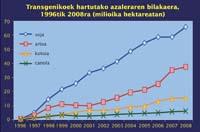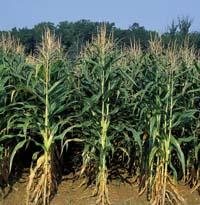The production of GMOs increases year after year
2008/04/01 Elhuyar Zientzia Iturria: Elhuyar aldizkaria
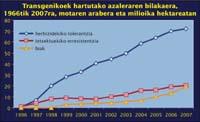
ISAAA is responsible for the applications of biotechnology in agriculture and publishes annually the data of the production of GMOs worldwide. According to this data, Spain remains the largest producer of GMOs in the European Union and, in addition, has consolidated its position by producing 40% more GM maize in 2007 than in the previous year.
In 1998 Europe approved the first GM: Bt corn. This transgenic maize contains a gene from the bacterium Bacillus thuringensis. This gene produces a protein against one of the insects that damage corn, making it an insect-resistant maize that destroys crops. All GMOs authorized by Europe since 1998 have been genetically modified maize varieties.
Within the Spanish state, Catalonia and Aragon are the countries in which more transgenic maize is made, but elsewhere have also significantly increased transgenic plantations. For example, in Extremadura they have tripled in the last year and in Navarre they have doubled. Thus, 21% of the maize made in the Spanish state is transgenic.
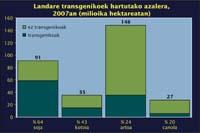
With this data, Spain is among the 12 largest producers in the world. In the first place are the United States, followed by Argentina, Brazil, Canada, India and China. The ISAAA organization has highlighted that there are more developing countries than those developed among producers, since the beginning of GM planting. Specifically, in 2007, GMOs were planted in 12 developing countries and in 11 developed countries.
According to ISAAA and other institutions, GM plants can be especially beneficial to people in developing countries. For this purpose, they have created, for example, rice rich in vitamins A and wheat that is not lost with droughts. However, for the time being, the owners of varieties grown in developing countries are mostly industrialized countries and import much of their production.
Besides this, the country that has grown more proportionally in the production of GMOs is India for the third consecutive year. Between 2006 and 2007 it has increased its production by 67%, highlighting cotton. In China, transgenic cotton has also grown a lot, so last year more than two-thirds of planted cotton was transgenic. They also grow papaya and transgenic poplars.
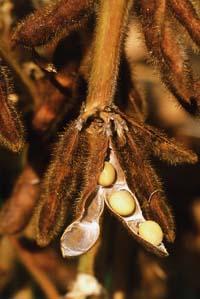
In absolute terms, Brazil is the country with the highest growth of GMOs. There it is mainly made soy and cotton, but the production of transgenic sugar cane is also increasing. It is used to manufacture ethanol and from now on those of ISAAA believe that it will occur even more.
But most are done in the United States. They produce soybeans, maize, pumpkin, papaya and transgenic alfallas, among others, and 93% of cotton produced last year was transgenic. In fact, the ISAAA report is funded by an American foundation, the Rockefeller Foundation, and one of the partners is Ibercaja, the fourth bank of Spain.

Gai honi buruzko eduki gehiago
Elhuyarrek garatutako teknologia



